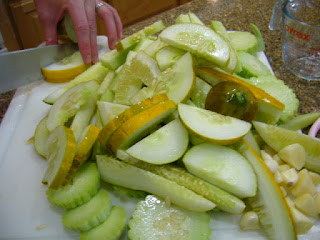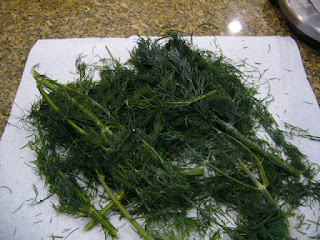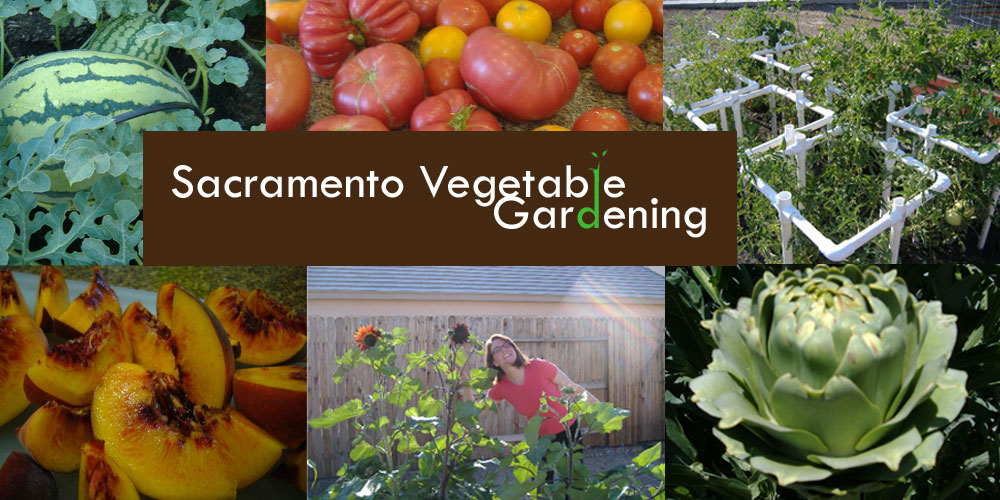 |
| Claussen Style Refrigerator Dill Pickles |
I'm not going to make many friends by posting experiences and recipes about a dish that is so hot it will burn your lips straight off!
But, I'm going to do it anyway.
It's mid-July in the Bird Back 40 and canning season has arrived. It would be nice if one could make an appointment with the garden for such things (how does next Tuesday sound to you?), but gardens don't make appointments. And one look at the vast number of ripening tomatoes kind of makes one feel -- uneasy. Hey -- I can eat tomatoes like nobody's business. But I don't plan on bathing in them anytime soon.
 |
| Pickling Cucumbers from the Bird Back 40 |
In this particular case -- the growing numbers of pickling cucumbers were causing the latest bout of concern. Look! There's one there! There's another! Soon -- glee would turn to dread with the question of, "where did those other five come from?" What in the world were we going to do with all those pickling cucumbers?
Easy! As the photo above demonstrates -- when the garden gives you pickling cucumbers -- you make pickles! You make lots and lots of pickles.
In our case that's about 12-one-quart jars and two refrigerator containers of lip-smackin (and lip-burnin' I might add) refrigerator pickles. Refrigerator pickles and canned pickles use the same types of recipes, with one major difference. Refrigerator pickles are not put through a canning process that can sometimes result in the bummer result of: soft pickles. Since you're not cooking them -- there's no chance for them to get soft. The downside to this equation is refrigerator pickles don't last as long, and can't be stored in a pantry until the urge to consume hits you.
 |
| Sliced and Ready for Canning |
Thus the name: Refrigerator pickles.
I must admit kids -- I am somewhat surprised. I'm also pleased to no end. See -- this year's garlic harvest was really nothing to write home about. I had intended to write a blog posting about this latest failure because half of the garlic harvest really wasn't a harvest at all. In fact, it was a complete bust. Garlic bulbs that should have been fat and happy with flavor were instead small and soft. In some cases? They disintegrated completely after the wife that is Venus and I pulled them out of the soil.
What remained of the harvest was rather small. There were no fat bulbs of garlic to be harvested this year. The best we got was something that you could purchase from your local grocery store. Where's the fun in that? The whole point of gardening is to produce a product that you CAN'T find in the local produce aisle.
 |
| Underwhelming Garlic Harvest? Mebbe Not! |
In that respect? We failed. MISERABLY!
This underwhelming garlic harvest has been sitting in and stinking up the garagemahal for about the past month --curing ever so slowly. As it turns out, this weekend's canning project was the first true test of our garlic growing efforts. Each jar would contain at least one clove of garlic and maybe more depending upon the size of said clove. How did our garlic turn out?
My bandaged lips should be the first sign that things weren't nearly as bad as I thought. In fact, the bandaged lips should indicate that this underwhelming harvest produced some of the hottest and tastiest garlic the Bird Back 40 has ever churned out. As I slowly bit into and savored that first test of home-grown garlic my eyes turned wide. They proceeded to turn even wider as that slow-moving burn sensation moved from lips to tongue to cheek. They nearly popped out of skull when the first whisps of smoke started to emerge from my ever-widening mouth.
 |
| Fresh Flaming Lips Garlic |
Holy Moly! Where did this heat come from? My lips are on fire! Quick! Water! Something! Ice! Defibrillator!
This is some good garlic! Much better than I ever could have imagined. Perhaps things aren't nearly as bad as I had believed they were.
Will the burn of the garlic transfer and infuse the dill pickles that are now slowly marinating on our front kitchen counter? Quite possibly. It's one reason why this year's refrigerator pickle production didn't also include a jalapeno pepper for each jar. We didn't feel the additional heat was needed. Our intention isn't to send our consumers screaming to the nearest available fire department location. Our intention is to provide them with the best pickle taste ever.
 |
| Not Concerned With Pickles Nor Garlic |
The best pickle taste is a mix of many things. It's salty. It's sweet. It's hot. It's cool. It's briny. It tastes like butter. In short -- it tastes like no pickle you've ever tasted before.
That's the goal with home-canned pickles. Sure! You can buy those kosher dills in any supermarket. Spears or chips -- you'll find them there.
But they won't taste anything like what we've got here. They probably won't burn your lips clean off either. Which, I suppose, is a good thing. But when burned lips result from a harvest that was better than expected -- well -- it's almost worth the price of Ace brand bandages.
CLAUSSEN STYLE REFRIGERATOR DILL PICKLES
This recipe is measured per jar, with the exception of the brine, depending upon the number of pickles you can pull from the backyard garden patch. We prefer pickling cucumbers, because they are a tad tougher than slicing cucumbers. Armenian cucumbers also work well because those tough skins retain that crunch, even after brining.
 |
| Fresh Dill Weed |
The basic water to vinegar ratio is three cups water to two cups white vinegar. Some recipes call for using cider vinegar, but that didn't sound appetizing to us, so we're sticking with straight, standard, white vinegar. Feel free to double or triple this brine amount, but stick with the ratio of three cups water for every two cups of white vinegar.
Bring three cups water to a boil and remove from heat completely to cool. After water has cooled -- add two cups vinegar. This is your standard brine mixture.
The ingredients listed below are what we used for each one-quart jar of pickles. You don't have to use one-quart jars. One gallon jars work just as well, or even plastic containers (think Gladware, Rubbermaid, etc.). We put our jars into a water bath canner for ten minutes to sterilize properly, but there are others who just run them through a hot dishwasher.
To each one quart jar, adding the following:
Two to three sprigs of fresh dill (which you remembered to plant this past spring)
One to two cloves of garlic, whole or cut in half
One Bay Leaf
One tablespoon of sea salt or canning salt
One teaspoon each of dried dill, mustard seed and peppercorns
 |
| Packed Jars: Ready for Brine |
Fill each jar with the required amount of seasonings, pack pickle spears or chips into jars, ladle in brine, seal, shake and set aside. Transfer to refrigerator after canning process is complete. Shake and turn jars upside down or right side up every day for ten days.
After 10-15 days, the refrigerator pickles should be ready for a pickle feast. Here's hoping you don't burn your lips off.

No comments:
Post a Comment